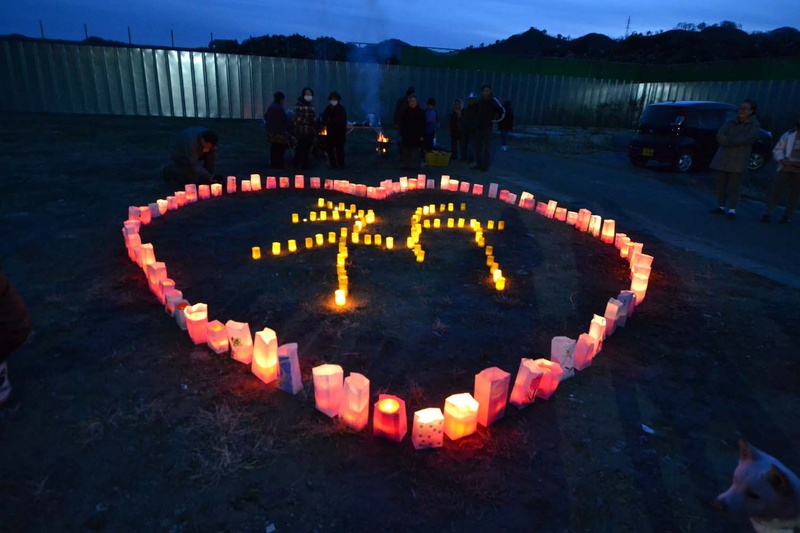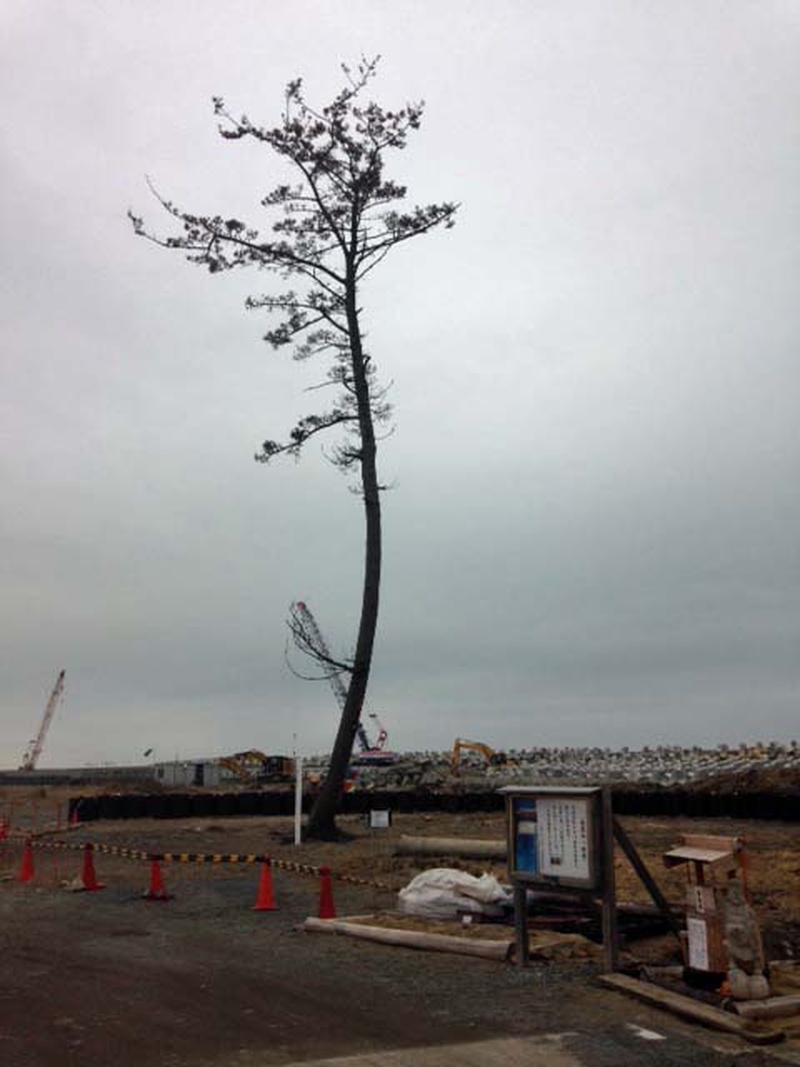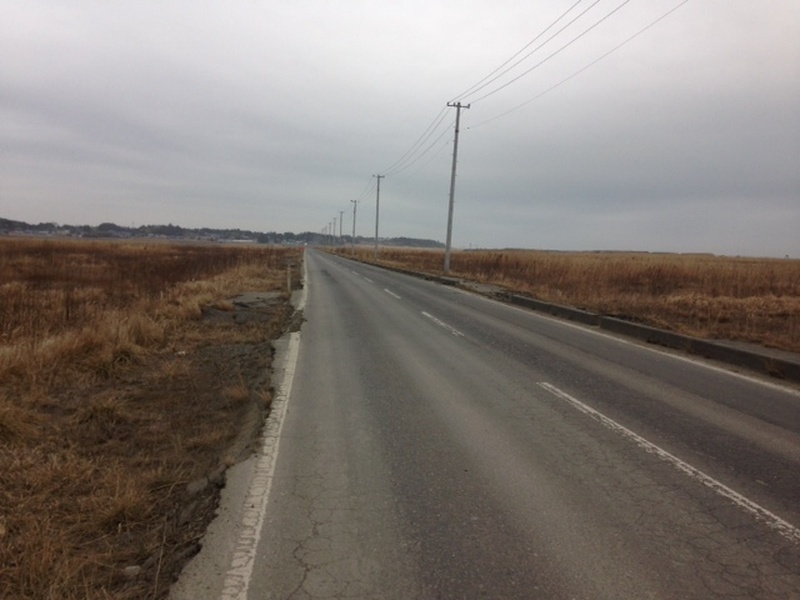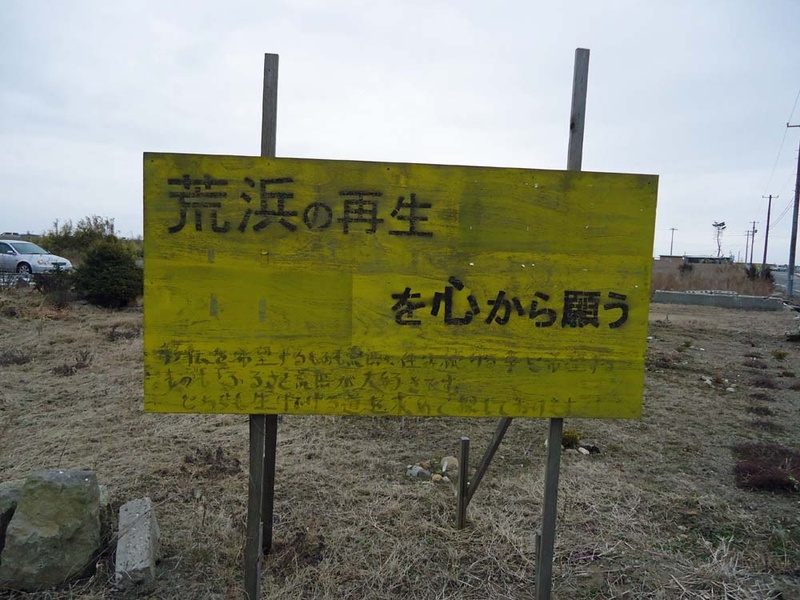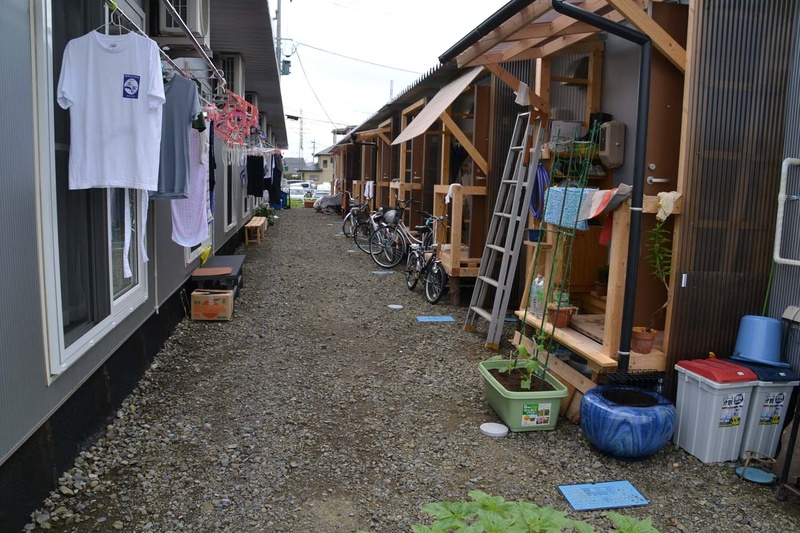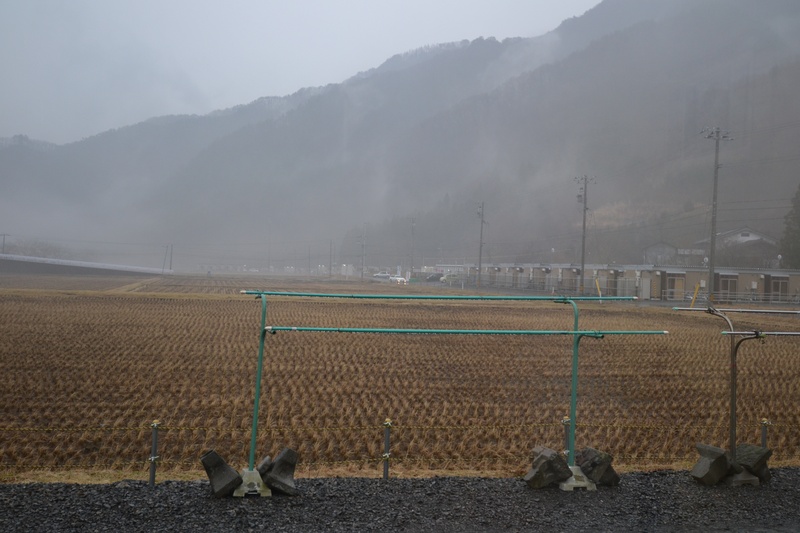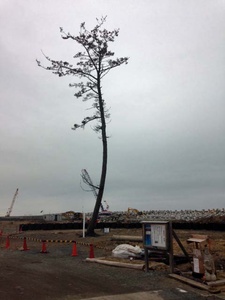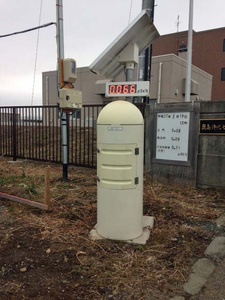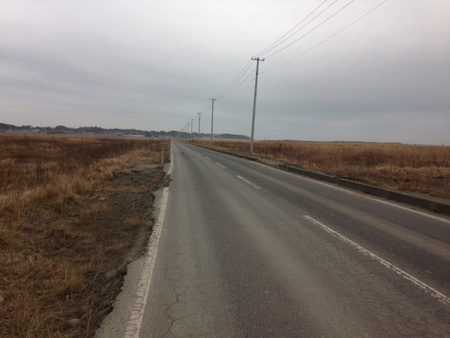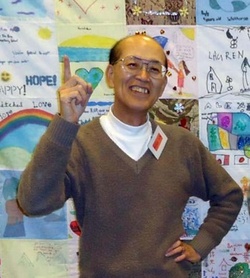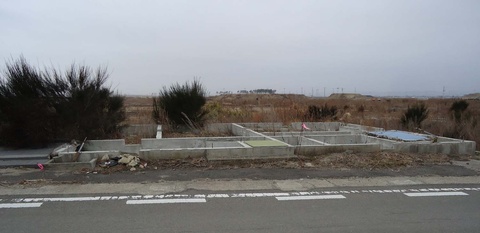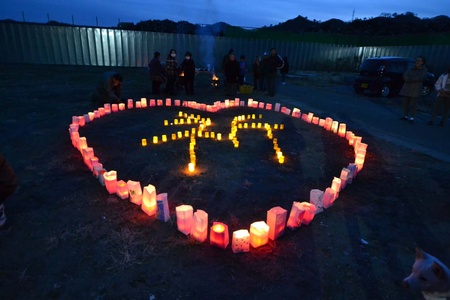Remember March 11, 2011?
I was just waking up and getting ready for school when I received a call from CBC radio asking for a comment when I still didn’t have a clue about the tragedy that had befallen the Tohoku region of Japan where I had lived for nine years.
There were the first frenetic and panicked TV images: the explosions at the Daiichi Nuclear Reactor in Fukushima, terrifying images of buildings shaking, falling apart, roads ripped apart, then that slow moving black wave crawling over the Tohoku shoreline then moving inland swallowing, engulfing everything, literally, cars, boats, trees, houses, buildings in its path in a cold, heartless wave of death and destruction.
Nothing is the same as it was before 3.11. Today, a friend’s family still lives in Minami Soma, Fukushima, close to the area that is still off limits because of the radiation hazard. When I asked Shogo for pictures, two stand out: one shows a lone pine tree that has taken on symbolic local importance; a second shows a radiation detector outside of a Fukushima public building whose presence alone tells a chilling truth.
“The radiation data is sent to the government and we can check out the radiation levels on a website,” he writes.
Shogo’s family rice farm was flooded by the tsunami and, as he avoids telling me whether his family is now farming the land, I surmise that the salt water has done long-term damage to the soil.
Shogo, a former English student, went to work in Yamagata city for a few years after 3.11 and was transferred to Sendai this past fall. His mother is doing work that is related to the 3.11 reconstruction effort. He goes on to tell me that his aunt and uncle are still living in “temporary housing.”
It is apparent to me, even from my vantage point here in Canada, that there is a certain amount of manipulation of truths happening. For example, we rarely ever hear media reports now from Fukushima about the radiation that school children are still being exposed to. Those who were able to flee are gone but what about those who were unable to leave like the elderly? Also, what happened to those dire warnings from nuclear experts about a nuclear meltdown? Remember TEPCO? Sadly, these human concerns seem to have vanished after the announcement that Tokyo had won the bid to host the 2020 Olympics. Priorities shift.
The steady stream of books and films coming out about 3.11 focus mostly on personal stories of loss which is an important part of the healing process. However, what is desperately needed now is for political leadership at all levels of government to step up with clear resolve to get the necessary help to those who are still very much homeless.
A report in the Toronto Star newspaper (January 17, 2015) reported the following figures in “Japan’s tsunami aftershock”:
$60 billion: Funds (in Canadian dollars) paid by central government to local governments in areas hardest hit; $36 billion: Portion of reconstruction money that has not been spent as of November 2014; 56,000 buildings damaged in the port city of Ishinomaki during the tsunami; 15% increase in Ishinomaki land prices last year as the government sought to buy 9,000 plots to build new homes; 2,700 housing units that have been completed (to date) of a planned 29,000. (Source: Reuters)
Nambu-san, a friend in Sendai and 3.11 volunteer put this into some context by giving two reasons for the slow recovery: “One of the reasons is the rising cost for construction of disaster public housing. The Japanese government has taken measures to counter economic depression for a long time, and, in addition, the Olympics will be held in Tokyo in 2020,” he says.
“Because of these factors, a lot of public works projects have been run here and there and many apartments and condominiums have been constructed nationwide. Those phenomena have brought about a shortage of construction workers for the affected areas. This makes for rising wages for the workers which affects the total cost for construction. When the bids were invited by the local governments of the affected areas, few construction firms would bid because the prices are not very attractive for them. It makes it very difficult for local governments to build the disaster public housing they have planned.
Nambu-san continues: “The other reason is that the local governments are having difficulty getting the land for collective relocations for the people living in the temporary housing.
There are few places which are flat in the Tohoku district. And it is taken that places near the sea are inappropriate for the people to live because there is a high risk of tsunami. It means that relocation sites for the local governments to choose are limited. And they need to buy pieces of land from landowners.
Before they buy, they need to make sure who actually owns the land. It is often very difficult for them to find the exact landowners. There are many cases where they are at a loss to determine who are the legal heirs of the land because the landowners passed away more than one hundred years ago or the landowners are unknown. This prevents the local governments from buying enough pieces of land for relocation sites. In addition to that, the number of the persons who are engaged in buying necessary pieces of land is fewer than needed.”
Vancouver filmmaker Linda Ohama was one of the first responders who organized fundraising events around Vancouver, launched the successful Cloth Letter Project that toured Japan and Canada and is now nearing completion of a documentary about 3.11.
Linda reports: “The situation in many parts of Tohoku seems to be gradually improving. Slowly. But there are still many challenges facing the people. Many of us, including the Japanese, have now stopped thinking about Tohoku, even Fukushima. People may even be imagining that life is ‘back to normal’ there. In places like Sendai, things seem normal enough. But as you go further up and down the coastline, you find the disparity.
It has almost been four years since the earthquake, tsunami, nuclear explosions and just a few days ago, February 16th, much of the same coastline had two large 6.9 earthquakes within a few hours. My friend emailed and said these were ‘the aftershocks of March 11, 2011.’ Another friend wrote and said the buildings were shaking, but that it doesn't scare them any more.
Many people are still living in ‘kasetsu,’ or relocated in other regions of Japan for health or employment reasons. Those who have remained in kasetsu are worn out, both mentally and physically.
The ‘kasetsu,’ by Japanese law, are temporary emergency housing built to house people for 2 years and built very simply in large clusters all over Tohoku. The ‘living room-dining room-often bedroom’ is one room: 2.73 meters by 2.73 meters. When you sit on the floor at the low table, your back is against the wall. If you talk too loud, your neighbour can hear you. People whisper a lot. When you go out the door, people know when you leave and what time you come back, what you were wearing and who you were with.
Recent statistics talk about overweight children. Because many kasetsu clusters are situated in remote areas, many kids get bussed to school instead of walking. And moms can’t go shopping for fresh food every day which is the normal Japanese custom.
It’s old news that more people have died in Minami Soma since the disaster than from the disaster, due to stress, confinement, and other health issues. Some people just ‘give up’ waiting. In Fukushima: Deaths in prolonged evacuation from nuclear disaster zone reached 1,656. Direct deaths from the earthquake and tsunami: 1,607. (Japan Times newspaper February 21 and February 24, 2014.)
According to the mayor of the small fishing town of Otsuchi that lost 10% of their population in the tsunami, 1,500 survivors left for elsewhere to find jobs since they have young families to support. And 4,800 town people were still living in 2,106 kasetsu (early 2014). That hasn’t changed much according to people living there.
Most people who moved away are the young, leaving an aging population behind. Many Tohoku towns, not only in Fukushima, have lost people to other places in Japan. When most of the businesses have been wiped out and the initial cleanup of debris jobs gone, people need to earn money. So they leave.
Once you find a job and your kids have a new school and new friends, the more time that passes, the harder it is to pack up and relocate a second time. As the governments do their decontamination in Fukushima, or rebuilding housing and industry in Iwate or Miyagi, the towns are beginning to ask their citizens to come home. People are four years older. A five year old then is now nine. A 60 year old is now 64. People have died. People have been born. As more time passes, more people are opting not to return to their hometown in Tohoku.
A good example of what is happening in Fukushima comes from an interview I had with a teacher that came from the evacuated town of Futaba near the nuclear plant.”
Speaking in English, a Futaba Junior High School teacher says, “I used to work at Futaba Junior High School. That school is about 4 km away from the Daiichi (nuclear) power plant so we had to evacuate. Before the earthquake, we had about 200 students and 20 teachers. But the school was… I don’t know how to say it… closed. So the students and teachers are spread all over Japan from Hokkaido to Kyushu.
The government is building a brand new school south of Iwaki City (Fukushima) opening soon. So, we sent a questionnaire to all former residents from Futaba with students: four junior high school students... maybe five or six kids will come back to attend the new school. So, five or six from the 200. The students who already moved away have restarted their new life in a different place because it’s been over three years since the earthquake.”
All this said about human losses, there are also many things like the new projects using renewable energies, the new research centers, new data, etc. that are positive outcomes from 2011. Japan, and the rest of the world could learn a lot from this tragedy, if we remain concerned, open, and caring.”
In April 2012, there were 123,630 living in some form of temporary housing. As of January 2015, 70,188 remain “displaced” mostly in either some form of prefabricated housing or private rental accommodation.
And, finally… There is no underestimating the complex conundrum that still faces Tohoku as Japan figures out its economic priorities (e.g., impressing the world at the 2020 Olympics or taking care of the needs of its people).
Still, four years later, as a certain woeful “forgetfulness” settles in, it is most troubling that more than 70,000 are still living in “temporary housing,” that the infrastructure of those coastal communities is still in shambles, that radiation concerns persist, and that billions of dollars that could be used to help are just sitting in banks. Where is the political determination to change the course of this troubling situation? Why does the recovery effort seem to be stalled?
Can we do anything more than pray that the next year will be a better one for the 3.11 survivors?
© 2015 Norm Ibuki


